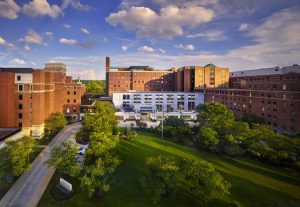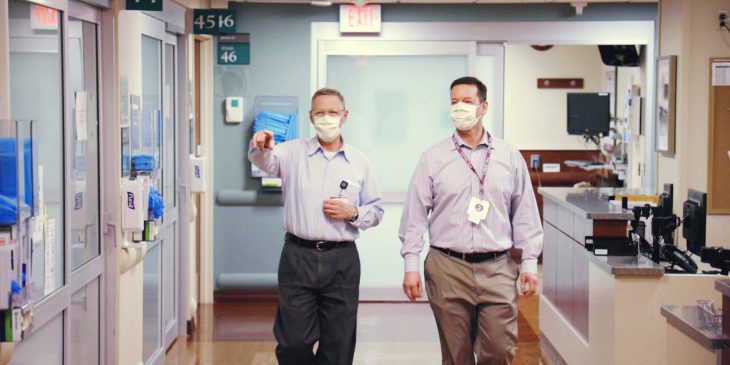Throughout 2020, public spaces like hospitals and businesses began to look different. Plastic shields were added, hand sanitizer bottles appeared and measured markings were drawn on the floor to encourage social distancing.

UPMC Shadyside
Because COVID-19 is primarily transmitted through respiratory droplets, it poses a unique challenge for those in charge of maintaining public spaces. At UPMC Shadyside, this challenge faced Pat Hogan, director of maintenance and engineering (pictured above on the left).
“We began preparations as the pandemic stretched into Europe and Italy, and then into the U.S. in New York. Everyone anticipated the worst-case scenario,” said Hogan, recalling February of 2020. “We assumed at the beginning of the pandemic that we would need droplet precautions.”
Back in March of 2020, little was known about COVID-19 and the way it spread. With guidance from the Centers for Disease Control and Prevention, hospital administration and infectious disease experts, Hogan and his team worked to convert the air flows in patient rooms and surgical suites, build mask dispensers, craft and install protective shields and make UPMC Shadyside a safe environment for patients and staff.
“What we do allows everyone else in the hospital to safely and comfortably do their jobs,” said Hogan. “We control things like heating and air conditioning, oxygen, and in general, help to keep the hospital running.”
Respiratory droplets are released when someone with COVID-19 sneezes, coughs or talks. If these infectious droplets are inhaled by other people, they can infect them with the virus. Transmission may occur by airborne droplets in some situations. Therefore, negative pressure rooms may be a safety measure to contain contaminated air for the care of some COVID-positive inpatients.
“Negative pressure essentially means that when you open the door, the air from inside that room won’t flow into the hallway. The air is exhausted out of the building as to not contaminate anyone else,” explained Hogan. “We have probably 10 or 12 of those rooms in different units throughout the facility normally. Knowing that we would need more, we looked at different areas of the hospital and worked to isolate patients coming into the hospital in certain units.”
In some rooms, windows had to be removed to allow for negative pressure adaptations. At one point, Hogan’s team had converted nearly 60 rooms in the hospital for potential inpatients with COVID-19.
UPMC Shadyside has been continuously updated throughout the pandemic with the ebb and flow of COVID-19 cases. Hogan often collaborates with maintenance and engineering directors at the other UPMC hospitals to share best practices and troubleshoot challenges.
“We started a facility engineering council 7 or 8 years ago. We meet monthly to share best practices and look at things that are new in the industry,” said Hogan. “We see what works at different places and how we can make things safer in our facility.”
One silver lining of the pandemic is that it’s helping UPMC engineers to better understand how to keep the hospitals safe for the future.
“This pandemic has influenced the way we will build things so that if we face something like this again, we’ll be able to handle it more easily,” said Hogan. “We’ve had opportunities to learn over this past 12 months. Nobody wanted this pandemic to happen, but at least we’ll be able to take what we’ve learned and apply it to the future.”
To learn more about the ways UPMC is keeping patients and staff safe during COVID-19, click here.









